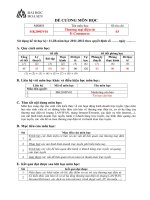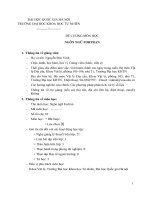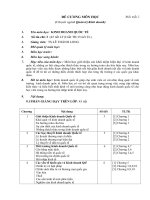Đề cương môn học
Bạn đang xem bản rút gọn của tài liệu. Xem và tải ngay bản đầy đủ của tài liệu tại đây (252.54 KB, 4 trang )
<span class='text_page_counter'>(1)</span><div class='page_container' data-page=1>
Fulbright School of Public Policy and Management
Academic Year 2018-20
Policy Evaluation Course Syllabus
1
<b>Fulbright School of Public Policy and Management </b>
<b>Master of Public Policy in Policy Analysis </b>
<b>Academic Year 2018-2020 </b>
<b>Summer 2019 </b>
<b>SYLLABUS </b>
<b>Policy Evaluation - 3 credits </b>
<b>Teaching team </b>
Visiting Professor: Edmund J. Malesky ()
Co-Instructor (and translator): Le Viet Phu ()
Teaching Assistant: Nguyen Bach Diep
<b>Class Meeting Time </b>
Lecture Hours: M-W-F (3.15 - 4.45 PM)
Office Hours: Le Viet Phu (Thu, 4 - 5.30 PM)
<b>Learning Objectives </b>
1. Understand the main objectives of rigorous policy evaluation, including how to avoid
common pitfalls that lead to incorrect conclusions.
2. Develop ability to select appropriate policy evaluation technique for specific government
intervention.
3. Become proficient at reading, analyzing and critiquing data derived from policy
evaluation.
4. Know how to design, implement, and interpret results from a simple Randomized
Controlled Trial (RCT).
5. Develop ability to construct a Pre-Analysis Plan (PAP), which describes theory of
change, outcome variables, analysis techniques, data visualizations for proposed
evaluations.
<b>Description </b>
</div>
<span class='text_page_counter'>(2)</span><div class='page_container' data-page=2>
Fulbright School of Public Policy and Management
Academic Year 2018-20
Policy Evaluation Course Syllabus
2
and then practice them immediately. The first lecture will be devoted to the goals and
organization of program design before beginning our discussion of the experimental ideal. Each
subsequent class will delve into particular research tools used in evaluation for attempting to
recover the experimental ideal (randomized control trials, survey experiments, regression
discontinuity design, matching estimators, and difference-in-differences). Within each lecture,
we will discuss the underlying assumptions, power estimations, and diagnostics for determining
whether the tool is appropriate for the particular research question.
The course will take the organizational structure of a workshop. Understanding the challenges of
teaching econometrics without formulas, we have selected a nuanced approach which offers a
harmonic, narrative based, combination of theory, in-class discussions, and computer
applications. The course assessment is based on identifying a critical policy question that
students are interested in and then designing the ideal evaluation for it. The final project will a
Pre-Analysis Plan, a specialized research design that lays out the specific for how a new policy
will be evaluated.
<b>Required Readings </b>
<i>• Angrist, Joshua and Jorn-Steffen Pischke. (2014). Mastering 'Metrics: The Path from </i>
<i>Cause to Effect. Princeton University Press. </i>
• Khandker, Shahidur R., Gayatri B. Koolwal, and Hussain A. Samad (KKS, 2010).
<i>Handbook on Impact Evaluation Quantitative Methods and Practices. The International </i>
Bank for Reconstruction and Development, The World Bank. eISBN: 978-0-8213-8029-1
• Evidence in Governance and Politics. (EGAP, 2018). Methods Guides.
<
• Additional short reading on specialized topics listed with hyperlinks below.
<b>Assessment </b>
<b>1. Participation: 10% </b>
Students will be provided with a daily set of discussion questions that we will cover in lecture.
Participation will be heavily influenced by the quality and sophistication of your answers to
those questions.
<b>2. Problem Sets: 30% </b>
Two problem sets using real world evaluations with actual data. Students will submit a .do file
analyzing the data and describing results. To get full credit .do file must run without error.
<b>3. Research proposal: 20% </b>
Write a 1-page description of theory, hypothesis, and ideas for testing for your final project.
<b>4. Pre-Analysis Plan: 40% </b>
</div>
<span class='text_page_counter'>(3)</span><div class='page_container' data-page=3>
Fulbright School of Public Policy and Management
Academic Year 2018-20
Policy Evaluation Course Syllabus
3
the class. Students will be expected to review the literature, explain the theory, detail hypotheses,
design all of the instruments, explain data collection strategy, and forecast potential pitfalls. The
goal is to leave the class with a plan that could quickly be turned into a realworld policy
<b>evaluation. </b>
<i>All problem set must be submitted by 08:20, in both electronic copy and hard copy in the box in </i>
<i><b>the lab room, unless otherwise instructed. For information relating to submissions, grievances, </b></i>
<i><b>academic dishonesty and special considerations please refer to the Student Guidelines. </b></i>
<b>Course Schedule </b>
<b>Section 1: Fundamentals of Policy Evaluation </b> <b>[Le Viet Phu] </b>
Wednesday, June 19: What is Policy Evaluation and Causal Inference?
<i>Importance of evaluation and the difference from monitoring, counterfactuals and the potential </i>
<i>outcomes framework </i>
• EGAP, “10 Strategies for Figuring Out if X Caused Y”
<i>EGAP, “10 Things You Need to Know about Causal Inference” </i>
<i>• Angrist and Pishke, Introduction. </i>
• KKS, pp 3-20.
<b>Section 2: Randomized Controlled Trials </b> <b> [Edmund Malesky] </b>
<b>Thursday, June 20 (1.30 – 4.45pm): Introduction to Randomized Controlled Trials (RCTs) </b>
<i>Basics of field experiments and exploration of different designs. </i>
• KKS, pp. 33-38.
• EGAP, “10 Types of Treatment Effects You Should Know About”.
• EGAP, “10 Things to Know about External Validity”.
<b>Friday, June 21 (3.15-4.45pm): Designing and Implementing an RCT: </b>
<i>Random assignment, sampling, blocking/stratification, and power calculations. </i>
• KKS, pp. 39-50.
<i>• Angrist and Pishke, Chapter 1. </i>
• EGAP, “10 Things to Know about Randomization”.
<b>Monday, June 24 (3.15-4.45pm): Advanced Topics in RCT Design: </b>
<i>Sub-sample analyses, testing for mechanisms, and spillover designs. </i>
• EGAP, “10 Things to Know about Mechanisms”.
• EGAP, “10 Things to Know about Spillovers”.
<b>Tuesday, June 25 (1.30-4.45pm): Case Study: Improving the Distribution of a Subsidised Rice </b>
<i>Programme in Indonesia. Study a famous policy evaluation in Indonesia from start to finish. </i>
</div>
<span class='text_page_counter'>(4)</span><div class='page_container' data-page=4>
Fulbright School of Public Policy and Management
Academic Year 2018-20
Policy Evaluation Course Syllabus
4
• KKS, pp. 171-179.
<b>• First Problem Set Released. </b>
<b>Section 3: Recovering the Experimental Idea through Natural Experiments [Le Viet Phu] </b>
Wednesday, June 26: Review of RCTs and Introduction to Natural Experiments
<i>What do we do when we are unable to randomize? </i>
Friday, June 28: Difference-in-Differences Analysis
<i>Basis assumptions and applications. </i>
• KKS, pp. 71-84, 189-201.
• Angrist and Pishke, Chapter 5.
Monday, July 1: Matching Estimators
<i>Basis assumptions and applications. </i>
• KKS, pp. 53-64, 181-188.
Wednesday, July 3: Regression Discontinuity Design
<i>Basis assumptions and applications. </i>
• KKS, 103-112, 211-216.
• Angrist and Pishke, Chapter 4.
<b>• First Problem Set Due/Second Problem Set Released. </b>
Friday, July 5: Review Section (Optional)
Monday, July 8: Regression Discontinuity Design (continued)
Wednesday, July 10: Building a Pre-Analysis Plan
• McKenzie, David. 2012. “A Pre-Analysis Plan Checklist.” World Bank
Development Impact Blog.
• Ganiminan, Alejandro. 2017. “Pre-Analysis Plan Template.” Berkeley Initiative
for Transparency in the Social Sciences.
Friday, July 12: Review Section (Optional)
Monday, July 15: Instrumental Variable Method
• KKS, 87-101, 203-209.
• Angrist and Pishke, Chapter 3.
Wednesday, July 17: Instrumental Variable Method (continued)
<b>• Second Problem Set Due. </b>
Friday, July 19: Review Section (Optional)
<b>• Pre-Analysis Plan Proposal Due. </b>
</div>
<!--links-->
<a href=' />





